Fleurs du Mal Magazine


Or see the index
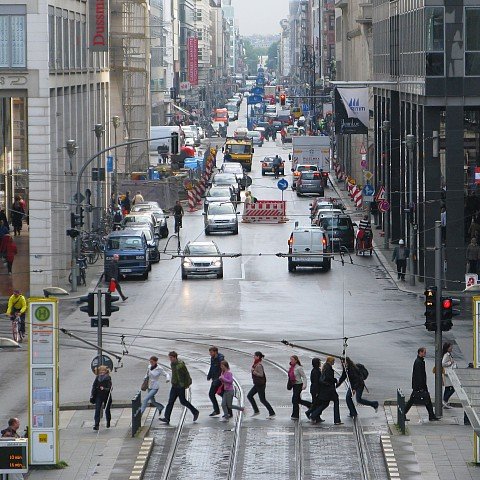
Paul Boldt
(1885-1921)
FRIEDRICHSTRASSENKROKI
3 UHR 20 NACHTS
Die Friedrichstraße trägt auf Stein
Die blassen Gewässer des Lichtes
Die Dirnen umstehn mit Hirschgeweihn
Die Circe meines Gesichtes.
Ich schaue: – Der Träume Phosphor rinnt
In zwei, vier Menschenaugen neu.
Wie eine Katze springt, gefleckt, der Wind
Zwischen des Asphalts Lichterstreu
Und trägt den fetten, weißen Rauch
Im Maul den jungen Winden ins Nest.
Er faßt die Dirnen an den Bauch
Und klemmt die dünnen Röcke fest.
– Da sind Gesichter, lachen nett,
Daß alle Zähne blecken müssen;
Die Louis zeigen ihr Skelett,
Louise läßt mich ihres küssen.
Paul Boldt poetry
fleursdumal.nl magazine
photo Anton K. 2009
More in: Archive A-B, Boldt, Paul, Expressionism
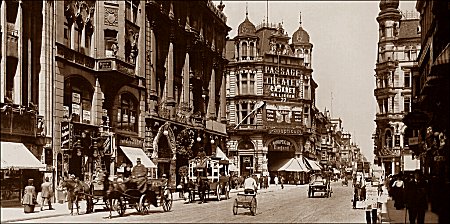
Paul Boldt
(1885-1921)
MÄDCHENNACHT
Der Mond ist warm, die Nacht ein Alkohol,
Der rasch erglühend mein Gehirn betrat,
Und deine Nacktheit weht wie der Passat
Trocknend ins Mark.
Du hast ein weißes Fleischkleid angezogen.
Mich hungert so – ich küsse deine Lippen.
Ich reiße dir die Brüste von den Rippen,
Wenn du nicht geil bist!
– Küsse sind Funken, elektrisches Lechzen
Kupferner Lippen, und die Körper knacken!
Mit einem Sprunge sitzt mein Kuß im Nacken
Und frißt dein Bäumen und dein erstes Ächzen.
Und als ich dir die weißen Knie und,
Dein Herz verlangend, allen Körper küßte,
Geriet mein Schröpfkopf unter deine Brüste;
Da drängte sich das Herz an meinen Mund.
GUTEN TAG – HELLE EVA!
Ich wollte mit dir jungem Weibe leben
Gern wie der Sturm auf einem hellen Meer,
Daß deine Hände sich wie Möwen heben.
Wie Strudel leuchten deine Brüste sehr.
Dein Fleisch ist Schnee, und schneereich bist du wie
Russische Winter. Mondrot leuchtet, blond,
Dein Haarkorb an des Nackens Horizont –
Du nackend Weib, du weiße Therapie!
Lange behielt ich deine Witterung
Und jagte hitzig hinter Dirnenrudeln,
Lustkrank, von Qual beweht. Doch du bliebst jung.
Auf deinen Rippen kreisen weiße Strudel;
Du bist ein Weib geworden – puh – fruchtbar,
Du blanker Bauch voll Blut und krautigem Haar.
Paul Boldt poetry
fleursdumal.nl magazine
More in: Archive A-B, Boldt, Paul, Expressionism

Paul Boldt
(1885-1921)
TIERGARTEN
Birken und Linden legen am Kanal
Unausgeruhtes sanft in seinen Spiegel.
Ins Nachtgewölbe rutscht der Mond, ein Igel,
Der Sterne jagt und frißt den Himmel kahl.
Mädchen sind da, und wir sind sehr vergnügt.
Ich schmeiße nach dem dicken Mond mit Steinen;
Die Betty küßt mich, und er soll nicht scheinen,
Weil Bella schweigt und naserümpfend rügt.
Die Sommerstädte liegen um den Park.
Es wird sehr hübsch! Der Süden wandert ein!
Die Sonne wächst! Wie nackte Männer stark
Schreiten die Tage, Frühjahr in den Hüften.
Die schwarzen Linden kommen überein,
Morgen zu grünen in den süßen Lüften!
Paul Boldt poetry
fleursdumal.nl magazine
More in: Archive A-B, Boldt, Paul, Expressionism
![]()
Gemeentemuseum Den Haag
László Moholy-Nagy
De kunst van het licht
t/m 1 mei 2011
Licht als kunst en kunst als licht. László Moholy-Nagy (1895-1946) speelde zijn leven lang met licht in zijn kunstwerken, of het nu ging om schilderijen, sculpturen, collages, foto’s, films, grafiek, boekomslagen of theaterdecors. Wat het potlood is voor de tekenaar is licht voor Moholy-Nagy. Hij leefde in de boeiende overgang naar de moderne tijd; het interbellum, de periode van beroemde kunstbewegingen als Bauhaus en De Stijl. Moholy-Nagy was een echte wereldburger, zijn leven was één lange reis, van zijn geboorteland Hongarije, naar Wenen, Berlijn, Amsterdam, Londen en Chicago. Soms opgejaagd door een dreigend politiek klimaat, dan weer op zoek naar een nieuwe artistieke uitdaging. Moholy-Nagy was een alleskunner, naast beeldend kunstenaar was hij ook intellectueel, criticus, denker en leraar, maar bovenal utopist. Aan de hand van meer dan 180 objecten uit 30 verschillende internationale collecties geeft het Gemeentemuseum Den Haag een groots overzicht van zijn artistieke nalatenschap.
László Moholy-Nagy introduceerde fotografie en film, met licht als essentieel ingrediënt, als hét beeldende middel van zijn tijd. Door toepassing fotografie en film werd kunst in één klap bereikbaar voor iedereen. Deze democratisering van de kunsten paste in het utopisch denken van Moholy-Nagy. Kunst was voor hem onderdeel van een levenshouding, een collectieve mentaliteit waarin kunst en alle andere aspecten van het leven samenvloeien in een Gesamtkunstwerk of, beter nog, Gesamtwerk, wat zou leiden tot gezamenlijke vooruitgang. Hij was overtuigd van de vormende functie van kunst. ‘Kunst is de slijpsteen van de zintuigen, die de blik, de geest en de waarnemingen scherpt’, zo stelde hij.
László Moholy-Nagy was de spin in het web van het Europese modernisme. Hij ontmoette kunstenaars van internationale naam en faam. Bijvoorbeeld de Russische constructivisten, met wier ideeën over de rol van de kunst in een verbeterde samenleving hij een verwantschap voelde. Verder leerde Moholy-Nagy Bauhaus-oprichter Walter Gropius kennen. Bauhaus is de bekende school voor architectuur, kunst en vormgeving, waarbij de persoonlijke ontwikkeling van de studenten een belangrijke rol speelde. Ook dit was onderdeel van het revolutionaire idee van de samensmelting van kunst en maatschappij. Moholy-Nagy werd docent aan het Bauhaus en toen hij later vertrok naar de Verenigde Staten richtte hij daar het New Bauhaus in Chicago op.
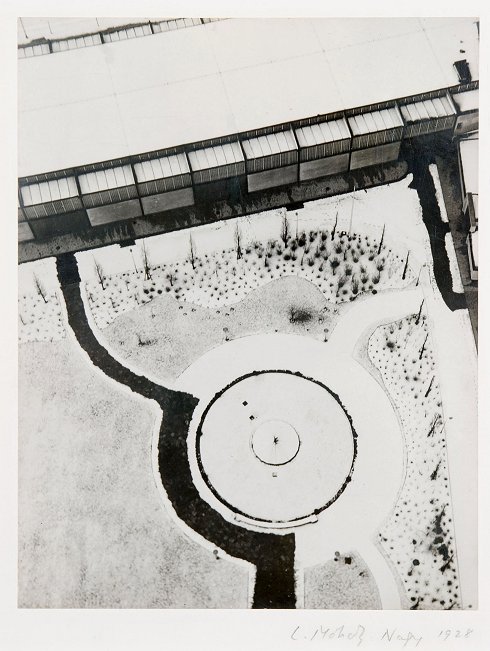
Naast een tiental schilderijen uit de periode 1922-1926, worden zijn belangrijkste films en meer dan honderd fotowerken van Moholy-Nagy in de tentoonstelling getoond. In de jaren dertig onderhield Moholy-Nagy intensieve banden met Nederland, hij woonde en werkte er zelfs twee jaar als art-director en legde er contact met Piet Mondriaan en Theo van Doesburg. In de tentoonstelling zijn dan ook verwante werken te zien van onder anderen Paul Schuitema, Piet Zwart en Gerard Kiljan. Naast grote namen uit de historische avant-garde als Piet Zwart, Georges Vantongerloo en Man Ray, past ook Moholy-Nagy uitstekend in het tentoonstellings- en collectiebeleid van het Gemeentemuseum Den Haag.
De tentoonstelling is tot stand gekomen in samenwerking met La Fabrica in Madrid (curator: Oliva Mario Rubio), Circulo de Bellas Artes in Madrid en Martin Gropius Bau in Berlijn. Bij de tentoonstelling is een Nederlandstalige catalogus verschenen, met essays van Oliva Maria Rubio (gastcurator), Vincenzo Vitiello, Frans Peterse, Hubertus von Amelunxen, Oliver A.I. Botar, Jeanpaul Goergen en Hattula Moholy-Nagy. (d’jonge Hond, ISBN 978-90-89101-95-2, verkoopprijs 49,50 euro)
fleursdumal.nl magazine
More in: Bauhaus, Constructivism
.jpg)
Paul Boldt
(1885-1921)
DER DICHTER
Die Antlitzlast auf seinen Schädelknochen,
Wie ein Museum, und die Schmerzen hängen
In großen Augen, blicklos und gebrochen,
Und in dem Mund, verzerrt von den Gesängen.
Es kommt heraus, Dunkles des Blutes, quillt.
Er wird wahnsinnig aus Liebhaberei.
Sein Mund geht lüstern auf. Er lächelt wild.
Hinter die Zähne bergend seinen Schrei.
Paul Boldt poetry
fleursdumal.nl magazine
More in: Archive A-B, Boldt, Paul, Expressionism
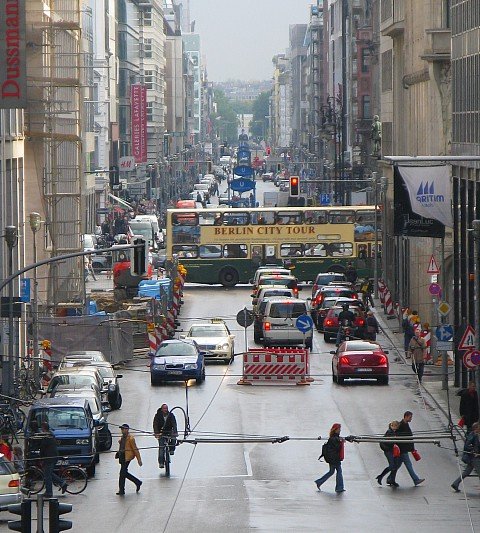
Paul Boldt
(1885-1921)
IMPRESSION DU SOIR
Des Abends schwarze Wolkenvögel flogen
Im Osten auf vom Fluß der Horizonte.
Gärten vertropft in Nacht, die, als es sonnte,
Wie See grünten und den Wind einsogen.
Einsame Pappeln pressen ihre Schreie
Angst vor den Stürmen in die blonde Stille.
Schon saugen schwarze Munde Atem. — Schrille
Fabrikenpfiffe. Menschen ziehn ins Freie.
Ein rotes Mohnfeld mit den schwarzen Köpfen,
Ragen die Schlote, einsam, krank und kahl.
Die Wolkenvögel, Eiter an den Kröpfen,
Wie Pelikane flattern sie zum Mahl.
Und als die Horizonte Dunkel schöpfen,
Wirft sich der Blitz heraus, der blanke Aal.
DER SCHNELLZUG
Es sprang am Walde auf in panischem Schrecke,
Die gelben Augen in die Nacht geschlagen. —
Die Weiche lärmt vom Hammerschlag der Wagen
Voll blanken Lärms, indes sie fern schon jagen
Im blinden Walde lauert an der Strecke
Die Kurve wach. Es schwanken die Verdecke.
Wie Schneesturm rennt der D-Zug durch die Ecke,
Und tänzelnd wiegen sich die schweren Wagen.
Der Nebel liegt, ein Lava, auf den Städten
Und färbt den Herbsttag grün. Auf weiter Reise
Wandert der Zug entlang den Kupferdrähten.
Der Führer fühlt den Schlag der Triebradkreise
Hinter dem Sternenkopfe des Kometen,
Der zischend hinfällt über das Geleise.
DAS GESPENST
Wie weiß der Sommer ist! Wie Menschenlachen,
Das alle Tage in der Stadt verschwenden.
Häuserspaliere wachsen hoch zu Wänden
Und Wolkenfelsen, die mich kleiner machen.
In tausend Straßen liege ich begraben.
Ich folge dir stets ohne mich zu wenden.
O hielte ich dein Antlitz in den Händen,
Das meine kranke Augen vor sich haben.
Ich küßte es. Es küßte mich im Bette —:
— Versprich, daß du mich morgen nicht mehr kennst!
— Bist du nachts fleischern und ein Taggespenst?
— Du locktest es ins Netz deiner Sonette.
— Junger Polyp, dein Mund ist eine Klette.
— Er wird dich beißen, wenn du ihn so nennst.
Paul Boldt poetry
fleursdumal.nl magazine
photo anton k.
More in: Archive A-B, Boldt, Paul, Expressionism

Paul Boldt
(1885-1921)
PROSERPINA
Einsamer Pluto trage ich im Blute
Proserpina, nackend, mit blonden Haaren.
Unauslöschbar. Ich will mich mit ihr paaren,
Die ich in allem hellen Weib vermute.
Ich bin von ihren Armen lichtgefleckt
Im Rücken! Ihre Knie sind nervös,
Die Schenkel weiß, fleischsträhnig, ein Erlös
Des weißen Tages, der die Erde deckt.
In ihrem Haar bleibt etwas vom Verwehten
Des warmen Bluts. Ich liebe den Geruch!
Und nur die Zähne haben zuviel Fades,
Wie Schulmädchen, sooft sie in den Bruch,
Den Brunnen ihres Frauenmundes treten,
Der meine Brünste tränkt – Herden des Hades.
Paul Boldt poetry
fleursdumal.nl magazine
More in: Archive A-B, Boldt, Paul, Expressionism
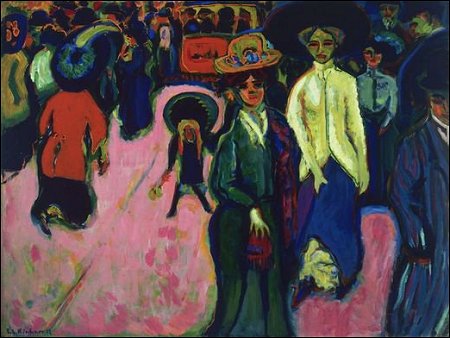
Paul Boldt
(1885-1921)
FRIEDRICHSTRASSENDIRNEN
Sie liegen immer in den Nebengassen,
Wie Fischerschuten gleich und gleich getakelt,
Vom Blick befühlt und kennerisch bemakelt,
Indes sie sich wie Schwäne schwimmen lassen.
Im Strom der Menge, auf des Fisches Route.
Ein Glatzkopf äugt, ein Rotaug’ spürt Tortur,
Da schießt ein Grünling vor, hängt an der Schnur,
Und schnellt an Deck einer bemalten Schute,
Gespannt von Wollust wie ein Projektil!
Die reißen sie aus ihm wie Eingeweide,
Gleich groben Küchenfrauen ohne viel
Von Sentiment. Dann rüsten sie schon wieder
Den neuen Fang. Sie schnallen sich in Seide
Und steigen ernst mit ihrem Lächeln nieder.
Paul Boldt poetry
fleursdumal.nl magazine
More in: Archive A-B, Boldt, Paul, Expressionism
Paul Boldt
(1885-1921)
DIE LIEBESFRAU
– Nackt. Ich bin es nicht gewohnt.
Du wirst so groß und so weiß,
Geliebte. Glitzernd wie Mond,
Wie der Mond im Mai.
Du bist zweibrüstig,
Behaart und muskelblank.
So hüftenrüstig
Und tänzerinnenschwank.
Gib dich her! Draußen fallen
Die Regen. Die Fenster sind leer,
Verbergen uns … – allen, allen! –
Wieviel wiegt dein Haar? Es ist sehr schwer.
– Wo sind deine Küsse? Meine Kehle ist gegallt,
Küsse du mich mit deinen Lippen!
– Frierst du? – – – Du bist so kalt
Und tot in deinen hellen Rippen.
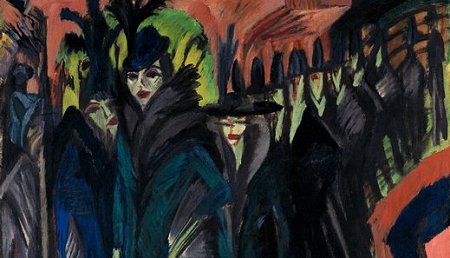
ERWACHSENE MÄDCHEN
Wer weiß seit Fragonard noch, was es heiße,
Zwei stracke Beine haben in dem Kleide;
Roben gefüllt von Fleisch, als ob die Seide
In jeder Falte mit dem Körper kreiße.
Aus dem Korsage fahren eure Hüften
Wie Bügeleisen in den Stoff der Röcke,
Darauf wie Bienen auf die Bienenstöcke
Unsere Blicke kriechen aus den Lüften.
Ihr jugendlichen Sonnen! Fleischern Licht!
Wir haben den Ehrgeiz der Allegorien
Und hübschen Dinge im Gedicht.
Ich will mit eurer Bettwärme Blumen ziehn!
Und einen kleinen Mond aus dem Urin,
Der sternenhell aus eurem Blute bricht!
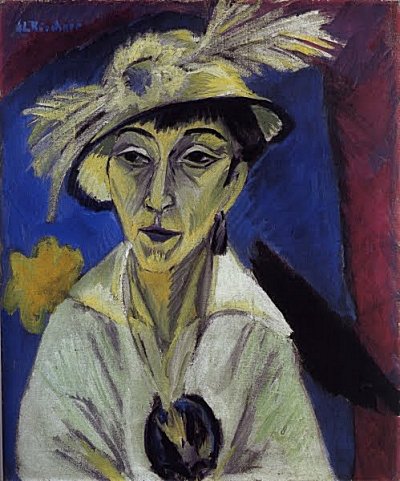
DIE SCHLAFENDE ERNA
Auf einer Ottomane aus Mohär
Liegt sie in Seidenröcken, eine Truhe
Voll Nacktheit, und ich denke voll Unruhe
An dein Geheimstes – schönes Sekretär.
Die Frauen tuen Wundervolles in die Seide.
Am Knie beginnt es. Ich will es auspellen,
Wenn Küsse summen nach hautsüßen Stellen
Im Bett, daß wir nicht schlafen können beide.
Du großes Mädchen, die noch kleinen Brüste
Schmücken dich mir. Auf den geheimen Schmuck
Hast du die linke weiße Hand gelegt;
Ich dachte: Soll die eine, die sie trägt –
Die schwarze Blume welken von dem Druck?
Und nahm die Hand weg, die ich leise küßte.
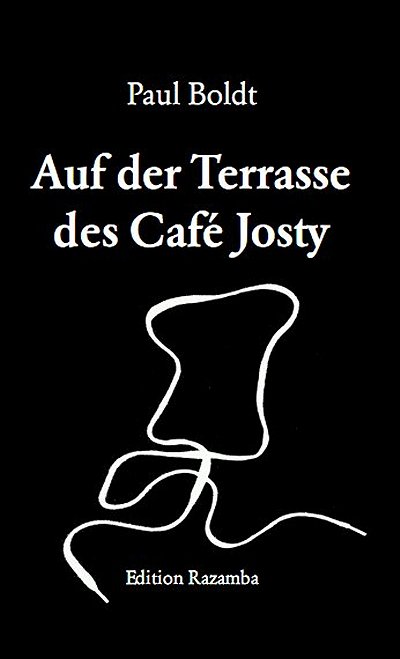
SINNLICHKEIT
Unter dem Monde liegt des Parks Skelett.
Der Wind schweigt weit. Doch wenn wir Schritte tun,
Beschwatzt der Schnee an deinen Stöckelschuhn
Der winterlichen Sterne Menuett.
Und wir entkleiden uns, seufzend vor Lust,
Und leuchten auf; du stehst mit hübschen Hüften
Und hellen Knien im Schnee, dem sehr verblüfften,
Wie eine schöne Bäuerin robust.
Wir wittern und die Tiere imitierend
Fliehn wir in den Alleen mit frischen Schrein.
Um deine Flanken steigt der Schnee moussierend.
Mein Blut ist fröhlicher als Feuerschein!
So rennen wir exzentrisches Ballett
Zum Pavillon hin durch die Türe ins Bett.
Paul Boldt poetry
fleursdumal.nl magazine
More in: Archive A-B, Boldt, Paul, Expressionism
Paul Boldt
(1885-1921)
DIE DIRNE
Die Zähne standen unbeteiligt, kühl
Gleich Fischen an den heißen Sommertagen.
Sie hatte sie in sein Gesicht geschlagen
Und trank es – trank – entschlossen dies Gefühl
In sich zu halten, denn sie ward ein wenig
Wie früher Mädchen und erlitt Verführung;
Er aber spürte bloß Berührung,
Den Mund wie einen Muskel, mager, sehnig.
Und sollte glauben an ihr Offenbaren,
Und sah, wie sie dann dastand – spiegelnackt –
Das Falsche, das Frisierte an den Haaren;
Und unwillig auf ihren schlechten Akt
Schlug er das Licht aus, legte sich zu ihr,
Mischend im Blut Entsetzen mit der Gier.
Paul Boldt poetry
fleursdumal.nl magazine
More in: Archive A-B, Boldt, Paul, Expressionism
![]()
Centre Pompidou Paris
MONDRIAN/DE STIJL
December 1, 2010 – March 21, 2011
The MONDRIAN/DE STIJL exhibition at the Centre Pompidou links the career of one of the greatest abstract painters of the 20th century to the story of one of the most fertile art movements of European modernism.
A key element of any understanding of the springs of modern art, between the end of the first decade of the century and the close of the Twenties the avant-garde movement De Stijl (Style) elaborated a vision of both art and society that aspired to universality, nourishing the ambition for a “total art.” It was in Paris, between 1912 and 1938, that Piet Mondrian, the central figure of the movement and its most famous representative, pursued his quest for visual harmony. Seeking a universal language of forms and primary colours, his radical abstraction sought to go beyond painting.
For Mondrian and other De Stijl artists, the total work of art was the key to a new world, the symbol of a renewed human community characterised by a perfect equilibrium in which each element combines with every other to form a whole.
The exhibition consists of two sections. The first, devoted to Mondrian, focuses on the drawings and paintings he produced in Paris between 1912 and 1938. Through some hundred major works, it shows the painter’s development from Cubism to Neo-Plasticism, from “natural reality to abstract reality,” reflecting the artistic dynamism that marked the painter’s years in the French capital.
This is the first time since 1969 that a large-scale exhibition of Mondrian’s work has been staged in the city where most of it was indeed produced.
The second section looks at De Stijl, examining it history in parallel with Mondrian’s career, through an outstanding selection of paintings, drawings and photographs. It has as its guiding thread the cross-disciplinary practice of the movement’s members, notably revealing the complexity of the collaborations between the painters, architects and designers who rallied around the three leading figures of Piet Mondrian, Theo van Doesburg and Gerrit Rietveld. To accompany this unprecedented exhibition, Éditions du Centre Pompidou are to publish two major works: Mondrian (ed. Brigitte Leal), and De Stijl, 1917–1931 (ed. Frédéric Migayrou and Aurélien Lemonier). Other publications will include Mondrian/De Stijl, an album of the exhibition; an edition of Mondrian’s French writings; the republication of his key text of 1920, Réalité naturelle, réalité abstraite; and a special number of the journal Les Cahiers du Musée.
PIET MONDRIAN (1872 – 1944)
Born in the Netherlands in 1872, Mondrian first received an academic training in Amsterdam, where he gained his first commissions (traditional portraits, decorative work for churches and private houses). At the start of the new century he was regularly painting, in a Symbolist vein, the farmhouses and countryside near his family home at Winterswijk, and already showing a marked interest in the rhythmic elements of composition (trees and fences), flatness (with the raising of the horizon line to counter the effect of depth) and the geometrization of forms.
Having moved to Paris in 1912, Mondrian discovered Picasso’s Cubism and abandoned the Divisionist- or Fauve-inspired painting, sometimes marked by theosophical influences, of his years in Domburg and Oele, to embark on the quest for a “universal pictorial language.”
Between 1912 and 1920, he gradually developed his Cubism towards Neo-Plasticism (the new, abstract, plastic art), moving from “natural reality to abstract reality.” Starting from the analytical decomposition of form, he developed a “pure” visual art based on the relationship between coloured surfaces and guided by a logic of harmony and equilibrium between elements. This horizontal/vertical dialectic, in which pure colours (blue, red, yellow) are juxtaposed with non-colours (black, white, grey) in a combinatorial geometry that abolishes perspective, allows for an infinity of modular variations. On this basis Mondrian produced during this period several series of paintings through which he developed his theology of Neo-Plasticism. These works are ordered in consistent, systematically developed series – the “plus-minus” works, the square compositions, the diamonds, the grids. “Everything is composed by relation and reciprocity. Colour exists only through another colour, dimension is defined by another dimension, there is no position except in opposition to another position.” The painting is open, seemingly a fragment of a much larger ensemble. The division of the canvas into rectangles echoes the frame, the wall on which the painting hangs, the room, the city about… Neo-Plasticism is a vision of precision that ties pictorial order to a social, spiritual and poetical utopia.
In his “sanctuary,” his studio at 26 Rue du Départ in Montparnasse – a space not so much decorated as treated as if it were itself a painting, furniture and easel included, to create a total art space – Mondrian lived meagrely but far from reclusively. This experimental
laboratory served as the headquarters of a considerable operation combining theoretical work, publishing and business, to promote the Neo-Plastic ideal and to develop and exploit his connections among all the abstract currents of Europe (Dada, De Stijl, Abstraction-
Création, etc.).
In 1915, the same studio was the site of his decisive encounter with Theo van Doesburg. In 1918, he launched the of the De Stijl manifesto. In 1921, he showed at Léonce Rosenberg’s Effort Moderne gallery, which also published his treatise Le néoplasticisme: Principe général de l’équivalence plastique, and staged the exhibition “De Stijl” in 1923. In 1925, Mondrian took part, together with other leading abstractionists, in the first international exhibition of non-figurative art, “L’Art d’Aujourd’hui.” In 1926, he did the stage design for Michel Seuphor’s L’Éphémère est éternel. In 1927, he published “Le Home – la Rue – la Cité” in Vouloir, showed at the Salon des Tuileries and exhibited at Jeanne Bucher’s. In 1931, he supported the formation of the Abstraction-Création group. In 1937, he took
part in the exhibition “Origines et développement de l’art international indépendant,” organised at the Jeu de Paume by Yvonne et Christian Zervos. During his twenty years in Paris, Mondrian got to know not only all the artists that mattered – the Delaunays, the Arps, Jean Hélion, Robert Mallet–Stevens, Pierre Chareau, Le Corbusier, the Cubists, the Constructivists, the Dadaists and the abstractionists, but also many young artists such as Calder, who came especially to Paris in 1930 to visit his studio.
In Paris too he found his first collectors, Frenchmen like Charles de Noailles, Americans like Albert Gallatin, Swiss like Alfred Roth, and also his first disciples, such as Jean Gorin and Félix Del Marle, and critics and eulogists like Christian Zervos and Michel Seuphor.
“A poem of right angles,” according to Le Corbusier, the Neo-Plasticist microcosm of 26 Rue du Départ became the crucial reference point of a new vision of the world that subordinated the individual to the universal . As such, it was visited by the greatest photographers
of the time, among them André Kertész, Rogi André and Florence Henri, who immortalised it in pictures published in art journals the whole world over.
Curator: Brigitte Leal
Assistant Director, Collections du Musée national d’art moderne/Centre de création industrielle
DE STIJL AND NEO-PLASTICISM
The Dutch avant-garde movement De Stijl (Style) is an essential key to any understanding of the springs of Modernism. It formed around three central figures: the painters Piet Mondrian and Theo van Doesburg and architect and furniture designer Gerrit Rietveld. Other members of the original group were painters Bart van der Leck, Georges Vantongerloo and Vilmos Huszar, architects JJP Oud, Robert van’t Hoff and Jan Wills, and poet Anthony Kok, who would be joined by graphic designer Piet Zwart and architect Cornelis van Eesteren.
It was in 1918, a year after the official foundation of the group and the publication of the first issue of the journal that publicised and promoted the movement’s teachings that the founders of De Stijl explicitly articulated the aesthetic and social vision that drew them together: the group’s first manifesto called for a new equilibrium between the individual and the universal and for the emancipation of art from the constraints of the cult of individualism. This quest for the utopian and universal might be summed up in the aphorism: “The goal of life is man; the goal of man is Style.”
Both utopian vision and practical engagement in the production of the real in an industrial world, De Stijl drew on the Hegelian tradition and on Theosophy, an esoteric doctrine then popular in the Netherlands and elsewhere. The founders of the movement were however primarily concerned with the formal – pictorial or architectural – expression of the principles of universal harmony. Painting, sculpture, graphics, furniture design, architecture and soon town planning served as the medium of experiment. De Stijl’s creations were multidisciplinary by nature, transcending the traditional academic boundaries between major and minor arts, between decorative art, architecture and urbanism.
The guiding theme of the movement during its fourteen years of productive existence might be taken to be the spirit of the city. The spatiality of the work of art gradually shifts from being the basis for an analysis of the world to a means of construction of the urban
social and political environment. In this respect, the spatialization of the work of art constitutes a specific experience of the world, ordering it and giving substance to community, embodying and making possible the equilibrium between individual and collective, between rational and sensuous, knowing and doing, spiritual and material.
For De Stijl, the priority was to find a formal language that answered to the problems of industrial society in the wake of the Great War and to adumbrate the strategies for the establishment of a new social order.
The method that served the vision was Neo-Plasticism, which at first represented a simple radicalisation of the avant-garde practice of the time. “The Cubists,” said Mondrian, “refuse to take their own artistic revolution to its logical conclusion. The modern sensibility cannot be reduced to the integration of multiple points of view, but must tend towards an immediately universal and rational plastic language.” Van Doesburg, for his part, called for “the elaboration, in connection with the plastic arts, of simple fundamental principles
understandable to all.” It was through the rigorous employment of primary colours alone (blue, yellow, red), unmodulated white and black, and straight lines laid out at right angles, and the limitation of forms and the geometrization of volumes that this brought that
the members of De Stijl invented a new grammar of forms. The analytical simplification of the formal lexicon and the harmonious dynamics of proportion offered no scope for tragedy, in the end projecting aesthetics as a universal.
Curator: Frédéric Migayrou
Assistant Director Musée national d’art moderne/ Centre de création industrielle
Assistant Curator: Aurélien Lemonier
Curator, Department of Architecture, Musée national d’art moderne/ Centre de création industrielle
AROUND THE EXHIBITION
INTERNATIONAL MONDRIAN COLLOQUIUM
WEDNESDAY 9 FEBRUARY 2011, 11 AM – 13 PM, 2.30 PM – 6.30 PM
PETITE SALLE, LEVEL -1
Admission free, subject to availability
To accompany the exhibition “Mondrian / De Stijl,” the Centre Pompidou is organising an international colloquium on Mondrian, under the direction of Brigitte Leal, curator of the exhibition and Assistant Director, Collections, at the Musée National d’Art Moderne, and Jean-Pierre Criqui, Head of Spoken Word at the MNAM and editor of the Cahiers du Musée national d’art moderne. The colloquium will consider the artist’s Paris years, but also different aspects of his work as they extend both before and after this period.
With:
Carel Blotkamp, Free University of Amsterdam
Yve-Alain Bois, Institute for Advanced Study, Princeton
Thierry de Duve, Université de Lille 3
Hans Janssen, Gemeentemuseum, The Hague
Guitemie Maldonado, Université de Paris 1
Georges Roque, CNRS, EHESS, Paris
INTERNATIONAL COLLOQUIUM: “DE STIJL, UNE AVANT-GARDE DU XXe SIÈCLE”
FRIDAY 21 JANUARY 2011, 2 PM – 8.30 PM, PETITE SALLE, LEVEL -1
The Bibliothèque Publique d’Information at the Centre Pompidou is organising a colloquium under the title “De Stijl, une avant-garde du XXe siècle.” This event, consisting of a series of presentations and a round-table discussion led by Frédéric Migayrou, Assistant Director of the Musée National d’Art Moderne / Centre de Création Industriel, curator of the De Stijl exhibition, and assistant curator Aurélien Lemonier, will bring together academics, art historians, architects and artists to consider De Stijl’s modernity.
With:
Michael White, Senior Lecturer in the History of Art, University of York
Marek Wieczorek, Associate Professor of Modern Art History, University of Washington
Philippe-Alain Michaud, curator and head of film at the Centre Pompidou
Valérie Guillaume, curator in chief and head of future technology at the Centre Pompidou
Round-table discussion with: Claude Parent, architect; Dominique Perrault, architect;
and Claude Rutault, artist
LA SEMAINE DE STIJL
From 9 to 14 February 2011, in connection with the Mondrian/De Stijl exhibition,
the Dutch Institute in Paris is organizing, in collaboration with the Centre Pompidou,
a series of events entitled “La Semaine De Stijl.”
Among the events are:
PAROLE AU GRAPHISME
FRIDAY 11 FEBRUARY 2011, AT 7PM, PETITE SALLE, LEVEL -1
Entrée libre dans la limite des places disponibles
A discussion of the typography and graphic design of the De Stijl period and its legacy today.
“Graphisme sous influence: l’héritage De Stijl à la Gerrit Rietveld Academie d’Amsterdam.”
CONCERT RED YELLOW + BOOGIE WOOGIE,
WITH THE QUARTET MONDRIAAN, AND GUUS JANSEN
SATURDAY 12 FEBRUARY 2011 AT 8PM, GRANDE SALLE, LEVEL -1
¤14, concessions ¤10
On the programme are Guus Janssen’s Café Society Downtown (2008) and a new work by the same composer, Anton Webern’s Langsamer Satz (1905), an extract from Jacob van Domselaer’s Proeven van stijlkunst (1913-16) (arr. Guus Janssen) and Morton Feldman’s Structures (1951).
SOIRÉE LETTRES MONDRIAN / VAN DOESBURG
MONDAY 14 FEBRUARY 2011 AT 7PM, PETITE SALLE, LEVEL –1
Entrée libre dans la limite des places disponibles
Staged reading of the unpublished letters of Piet Mondrian (1872-1944) and Theo van Doesburg (1883-1931), conserved at the Fondation Custodia in Paris. The reading will be preceded by an opportunity to view these hand-written letters by two key figures of the
De Stijl movement.
Part of the programme of BPI events.
CHRONOLOGY MONDRIAN
7 March 1872 Pieter Cornelis Mondriaan born at Amersfoort.
1892 Moves to Amsterdam, enrols at the academy of Fine Arts.
1897 Becomes a member of the St Luke’s painters’ group, which stages annual exhibitions at the Stedelijk Museum.
Receives his first commissions (traditional portraits, interiors for churches and private clients).
Regularly paints, in Symbolist vein, the landscapes and farms near the family home at Winterswijk.
Already shows an interest in the rhythmic elements of composition (trees and fences) and in flatness (raising the horizon line to counter the effect of depth).
1904-1906 Paints mills, haystacks and views of the River Gein. His painting becomes Expressionist and Fauve, embarking upon a “clarification of the plastic image” (Seuphor).
1908 At Domburg, concentrates on the motifs of church, lighthouse, dunes and sea. The brushwork is sometimes Divisionist (inspired by Jan Toorop) and areas of flat colour are increasingly present. Begins to explore the Theosophy of Helena Blavatsky and the ideas of Rudolf Steiner.
1909 Major Spoor, Mondrian and Sluyters retrospective at the Stedelijk Museum, Amsterdam.
Joins the Netherlands Theosophical Society.
1911 First visit to Paris. Mondrian would have been able to visit the Salon des Indépendants with its Room 41, considered to be the first major collective manifestation of Cubism.
1912 Mondrian moves to Paris. Shows at the 28th Salon des Indépendants, henceforth signing his name Mondrian with a single “a”. Influenced by the Cubists, he paints nudes, still lifes (Still Life with Ginger Pot) and views of Parisian buildings. Adopts Analytical Cubism. The evidence of reality disappears behind the network of geometrical lines and patches of graded monochrome.
1913 His presence at the Salon des Artistes Indépendants is noted by Guillaume Apollinaire, who mentions “Mondrian’s very abstract Cubism” in his report.
1914 Goes back to Holland and is unable to return to Paris on account of the war.
1915-1916 Goes to live in Laren. Meets Theo van Doesburg, Bart van der Leck and the theosophist Schoenmaekers.
The real “beginning of his art”: the subject disappears, paintings consist of simple areas of colour or lines forming “pluses and minuses”.
1917 Publishes a series of articles in the journal De Stijl, which will appear monthly until 1932.
1919 Returns to Paris.
1921 Publication of the pamphlet Le Néo-plasticisme. Principe général de l’équivalence plastique is published by Léonce Rosenberg’s Galerie de l’Effort Moderne. In his earliest Neoplasticist paintings, squares and rectangles of primary colours, or of black, are organised within an asymmetrical grid of black lines. With the flat (“Het Vlak”) he sought to do away with space and volume, going beyond visible nature to arrive at “a purer (cosmic) manner.” The artist was to understand colours intuitively and integrate them into a harmonious composition.
Takes part in the exhibition “Les Maîtres du Cubisme” at Galerie de L’Effort Moderne,” alongside Picasso, Braque, Gris, and Léger amongst others.
Settles at 26, rue du Départ. Very quickly begins to fix painted boards to the walls of the studio, which becomes the abstract concretisation of paintings to come.
1922 Retrospective organised by the Stedelijk Museum to mark the artist’s 50th birthday.
Despite artistic recognition, Mondrian lives in poverty, continuing to do flower paintings that he sells to make a living.
1923 Meets Michel Seuphor. Takes part in the first big De Stijl exhibition in Berlin.
1924 Gives greater emphasis in his paintings to the white background and black lines.
1925 Break with Van Doesburg.
1926 Makes drawings of an abstract interior for Ida Bienert of Dresden.
Maquette of Neoplasticist stage design for Michel Seuphor’s L’Éphémère est Éternel.
André Kertész shoots a series of photographs of Mondrian’s studio.
1927 Mondrian’s work first shown in the US by Katherine Dreier. The article “Le jazz et le néo-plasticisme” proposes a new conception of rhythm.
1930 Contributes to the journal Cercle et Carré and to the group show of the same title.
1931 Joins the Abstraction-Création association. Death of Van Doesburg, to whom he pays tribute in the last number of De Stijl the following year.
1932 Move to the double line, which emerges as a distinct form of construction.
A retrospective at the Stedelijk Museum in Amsterdam marks his 60th birthday.
1934 Attends a Louis Armstrong concert at the Salle Pleyel.
Regularly meets with the young American painter Harry Holtzman, who is visiting Paris.
1935 Exhibition “Cubism and Abstract Art” at the Museum of Modern Art, New York. The catalogue devotes a whole chapter to Mondrian and De Stijl.
1937 Exhibition “Origines et développement de l’art international indépendant” at the Musée du Jeu de Paume, curated by Christian Zervos.
1938 Leaves Paris for London, moving in with Ben Nicholson.
1940 Arrives in New York. Finds accommodation through Harry Holtzman, who introduces him to boogie-woogie.
1941 Shows New York City I, consisting of coloured lines. Also starts using strips of coloured paper.
1 February 1944 Death of Mondrian. His last painting, Victory Boogie-Woogie, remains unfinished. Fritz Glarner and Harry Holtzman shoots a series of photographs and a film of his studio in New York.
1945 “Piet Mondrian” retrospective at MoMA.
1957 Exhibition “Mondrian, l’organisation de l’espace” at Galerie Denise René in Paris.
1969 Most recent French retrospective of Mondrian’s work at the Orangerie des Tuileries, organised by Michel Seuphor.
DE STIJL CHRONOLOGY
1914 Summer: Piet Mondrian moves to Laren, in Holland, the declaration of war making it impossible for him to return to Paris, where he has lived since 1912. Theo van Doesburg is mobilised and sent to the Belgian frontier near Tilburg, where he gets to know poets Evert Rinsema and Antony Kok.
1915 November: Van Doesburg publishes in the journal Eenheid an article on the work of Mondrian, which he has recently discovered.
1916 January-February: Van Doesburg visits Mondrian, who introduces him to the German theosophist Mathieu Hubertus Josephus Schoenmaekers.
March-June: Theo van Doesburg, Eric Wichman and Louis Saalborn establish the artist’s society De Anderen [The Others].
May: Van Doesburg meets architects Jacobus Johannes Pieter Oud and Jan Wils and painter Bart Van der Leck.
Together they establish in Leiden the artists’ society De Sphinx, whose goal is to promote a closer relation between architecture and painting.
This is the beginning of a period of cooperation between the painter and the architects, for whom he produces interior colour schemes and stained-glass windows. His work is close to that of Vilmos Huszár in the same period. Robert van’t Hoff builds the Henny villa at Huis-ter-Heide, whose geometric radicalism wins international recognition. Helene Kröller-Müller acquires recent works by Van der Leck, whose simplified forms and areas of flat primary colour bring it very close to pure abstraction.
1917 Van Doesburg makes his first Neoplastic paintings, called Compositions, based on the use of geometrical grids in accordance with Mondrian’s precepts.
October: Publication of the first issue of the journal De Stijl, whose editor is Van Doesburg. Among the contributors are the painters Mondrian, Van der Leck, Huszár, Gino Severini and Georges Vantongerloo, the poet Kok and architects Oud, Wils, Huib Hoste and Van’t Hoff.
1918 Influenced by De Stijl principles, Gerrit Rietveld develops a first version of the Red-Blue Chair. Van Doesburg conceives the colour scheme for the hotel-restaurant De Dubbele Sleutel, designed by Wils, and for the Bart De Ligt house, designed by Van’t Hoff. He produces stained-glass windows for J.J.P. Oud’s workers’ housing project at Spangen in Rotterdam.
November: Publication of the first manifesto in De Stijl.
1919 The journal is widely distributed in Europe, and includes information on artistic activities abroad.
July: Mondrian leaves for Paris.
1920 February-March: Van Doesburg stays in Paris as Mondrian’s guest. He meets Léonce Rosenberg, director of the Galerie L’Effort Moderne.
April: Theo van Doesburg, Piet Mondrian and Antony Kok sign the second De Stijl manifesto, devoted this time to literature. Piet Zwart collaborates with Jan Wils, designing the colour scheme for the Dansinstituut Gaillard-Jorissen in The Hague and the Bruynzeel Fabrieken in Zaandam.
May: Van Doesburg adopts the pseudonym of I.K. Bonset, Dada poet.
June-November: He organises in the Netherlands the exhibition “La Section d’Or – Paris. Kubisten en Neo-Kubisten.”
18 December 1920 – 3 January 1921: Van Doesburg’s first visit to Germany, taking in Walter Gropius’s Bauhaus in Weimar.
1921 Van Doesburg devotes himself to architectural collaborations. He conceives of colour as the instrument of so radical a dynamization and destructuring of architecture that Oud terminates their relationship and quits De Stijl.
17 March – 28 April : Theo van Doesburg and Nelly van Moorsel travel through Europe. They meet Tristan Tzara.
28 April – late 1921: Van Doesburg moves to Weimar, from where he edits De Stijl. The journal opens its pages to new authors: Hans Richter, Kurt Schwitters, Raoul Hausmann, Clément Pansaers…
May: Van Doesburg’s first philosophical articles published under the pseudonym Aldo Camini.
August: Publication in the journal of the third De Stijl manifesto, “Towards a new World Plasticism.”
1922 Van Doesburg launches the journal Mécano (Leiden, 1922-1923).
8 March-8 July: Van Doesburg offers Bauhaus students a course on De Stijl.
Gets to know the Dutch architect Cornelis van Eesteren, the encounter marking the beginning of a close collaboration.
Van Doesburg is behind the International Congress of Progressive Artists held in Düsseldorf
(29-31 May) and the Constructivist and Dadaist Congress at Weimar (25 September).
1923 January-April: “Dada Tour” of Holland by Nelly van Moorsel, Theo van Doesburg, Kurt Schwitters and Vilmos Huszár.
May: Theo van Doesburg and Nelly van Moorsel move to Paris.
May-October: Huszár and Rietveld submit Composition spatiale et colorée to the Grosse Berliner Kunstausstellung and the Juryfreie Kunstschau in Berlin.
15 October – 15 November: Exhibition “Les Architectes du groupe De Stijl” at the Galerie L’Effort Moderne in Paris. Van Doesburg and Van Eesteren show three projects for houses they call Counter-constructions.
1924 Gerrit Rietveld and Truus Schröder-Schräder build the Schröder House in Utrecht. An architectural manifesto for De Stijl, it wins international recognition. César Domela joins the group.
March-April: “L’architecture et les arts qui s’y rattachent,” a De Stijl exhibition at the École Spéciale d’Architecture, Paris.
In a work entitled Contre-composition, Van Doesburg introduces the diagonal into his painting, calling “Elementarism” this painterly result of his architectural collaboration with Van Eesteren. The break with Mondrian is complete.
In Rotterdam, Oud builds the Café De Unie in accordance with De Stijl principles.
November: The Bulletin de L’Effort Moderne publishes the fifth De Stijl manifesto, “Vers une construction collective,” signed by Van Doesburg and Van Eesteren.
1925 Munich’s Bauhausbücher publishes Van Doesburg’s Grundbegriffe der neuen Gestaltenden Kunst and Mondrian’s Neue Gestaltung, Neoplastizismus, Nieuwe Beelding.
Van Eesteren wins the competition for the redesign of Unter der Linden in Berlin.
June: At the Paris Exhibition, Frederick Kiesler shows City in Space, an application of Neoplasticism to urban design.
The Vicomte de Noailles commissions a mural decoration from Van Doesburg for the “flower room” in the villa built for him at Hyères by Robert Mallet- Stevens.
July: Van Doesburg publishes the “Elementarist Manifesto.”
September: Renovation of the Café de l’Aubette begins in Strasbourg, under Van Doesburg, who is assisted by Hans Arp and Sophie Taueber-Arp. It is completed in 1928.
1927 For the 10th anniversary of De Stijl, Van Doesburg publishes a special number covering the group’s activities over the decade.
1928 June: Rietveld is one of the founder members of the Congrès Internationaux d’Architecture Moderne (Ciam), established on the initiative of Le Corbusier and Sigfried Giedion. With them he signs the “La Sarraz Declaration.”
1929 Van Doesburg builds a house and studio at Meudon
Van Eesteren is appointed head of the Amsterdam urban planning department, working on the extension of the city.
1930 18 April-1 May: The Cercle et Carré group’s exhibition at Galerie 23 in Paris includes works by some 50 artists, among them Vantongerloo and Arp. Mondrian and Michel Seuphor show their joint work, Tableau-poème. In reaction, Van Doesburg launches the journal Art concret, in defence of radical abstraction.
1931 February: The Abstraction-Création group is founded in Paris by Auguste Herbin, Theo van Doesburg and Jean Hélion.
7 March: Van Doesburg dies of a heart attack at Davos in Switzerland, where he had gone for health reasons.
1932 January: A last issue of De Stijl is published, in tribute to Theo van Doesburg.
Source Centre Pompidou Paris
Centre Pompidou Paris
MONDRIAN/DE STIJL
December 1, 2010 – March 21, 2011
fleursdumal.nl magazine
More in: De Stijl, Essays about Van Doesburg, Kok, Mondriaan, Schwitters, Milius & Van Moorsel, Piet Mondriaan
![]()
RIETVELDJAAR Utrecht
24 juni 2010 – 30 januari 2011
Over het Rietveldjaar
De stad Utrecht is er trots op dat de meeste Rietveldgebouwen binnen haar grenzen liggen en dat het gemeentelijke Centraal Museum de grootste Rietveldcollectie ter wereld heeft.
Daarom heeft de stad Utrecht 2010 tot Rietveldjaar uitgeroepen als startpunt in een meerjaren campagne om Rietveld als icoon van de stad Utrecht te profileren en zijn naam blijvend aan Utrecht te verbinden. Het Rietveldjaar wordt gelanceerd op 24 juni, de verjaardag van Rietveld. Vanaf dan vinden er wekelijks activiteiten plaats in de stad, de provincie maar ook daarbuiten. Er wordt samengewerkt met verschillende partners zoals onder andere het Nederlands Filmfestival, Hogeschool voor de Kunsten Utrecht, bewoners van Rietveldhuizen, Armando Museum, Kröller Müller Museum, Dick Bruna, Krisztina de Châtel, Stichting Rietveldprijs, Studium Generale Utrecht, C-mon & Kypski, poppodium Tivoli, Culturele Zondagen en Premsela. Het multidisciplinaire karakter van het programma wordt ingezet om een breed en divers publiek te interesseren voor Rietveld en de tentoonstelling Rietvelds Universum.
Het Centraal Museum laat zien dat Utrecht al eeuwenlang geldt als voedingsbodem voor artistiek en cultureel talent van nationaal en internationaal niveau. Zo beschikt het oudste stedelijk museum van Nederland over de grootste collectie Rietveld-objecten ter wereld en toont het werk van de wereldberoemde Dick Bruna. Ook de collectie oude meesters met onder andere werken van Jan van Scorel, Abraham Bloemaert en Hendrick ter Brugghen is zeer de moeite waard. Naast het werk van al deze Utrechtse iconen biedt het Centraal Museum een overzicht van 2000 jaar turbulente geschiedenis, maar staat ook het nu centraal met actuele mode, vormgeving en beeldende kunst.
Het museum is grotendeels gevestigd in een voormalig middeleeuws klooster. Andere delen van het gebouw hebben dienst gedaan als weeshuis, militaire paardenstal en psychiatrisch ziekenhuis. Het is in 1999 verbouwd door de architecten Stéphane Beel, Lieven Achtergael en Peter Versseput. Het museum bestaat uit een verzameling gebouwen rond een grote binnentuin.
Gerrit Rietveld (1888-1964)
Van krullenjongen tot architect
Gerrit ging als twaalfjarig jongetje werken in het meubelmakersbedrijf van zijn vader. Daar leerde hij stap voor stap de kneepjes van het vak. Zijn creativiteit kon hij echter niet kwijt in het kopiëren van klassieke stijlmeubelen. Rietveld wilde duidelijk meer.
Vier jaar lang volgde Rietveld avondcursussen bij het Utrechts Museum voor Kunstnijverheid en bij architect P.C. Klaarhamer. Hij kwam hierdoor in aanraking met de nieuwste ontwikkelingen op het gebied van de architectuur, vormgeving en beeldende kunst. In 1917 opende hij zijn eigen werkplaats, waarna hij in korte tijd een reeks revolutionaire stoelen ontwierp, waarvan de rood-blauwe stoel later wereldberoemd zou worden. De filosofie achter het ontwerp van deze stoelen was nauw verwant aan de ideeën van De Stijl beweging, waaraan ook schilders Bart van der Leck en Piet Mondriaan, en de architecten Theo van Doesburg en J.J.P. Oud deelnamen. De beweging groeide uit tot een van de belangrijkste avant-garde stromingen in de 20ste eeuw.
Hoewel Rietveld in die tijd toetrad tot de internationale avant-garde van de beeldende kunst en architectuur, leverde het hem nauwelijks betaald werk op. Via via kwam hij in contact met Truus Schröder-Schräder. Een ontmoeting met verstrekkende gevolgen. Na het overlijden van haar echtgenoot vroeg Truus Schröder aan Rietveld een voorstel te maken voor een nieuw te bouwen woonhuis aan de Prins Hendriklaan 50. Het was zijn eerste volwaardige bouwproject en daardoor dé kans zijn droom om architect te worden te realiseren. Truus Schröder bleek de ideale opdrachtgever. Ze gaf hem niet alleen alle vrijheid, maar daagde hem ook uit zijn ideeën in een ongekende vorm te gieten. Het resulteerde in een revolutionair manifest voor een nieuwe architectuur. In 2000 is het Rietveld Schröderhuis door de UNESCO op de Werelderfgoedlijst geplaatst en werd daarmee definitief een van de iconen van de twintigste-eeuwse architectuurgeschiedenis.
Vestiging als architect
Na de oplevering van het Rietveld Schröderhuis, in januari 1925, vestigde hij zich als architect in de atelierruimte op de begane grond. In de jaren vlak daarna ontwierp hij verscheidene fraaie projecten, o.a. de Erasmuslaan en ontwikkelde hij ideeën over woningbouw en massaproductie die de kern van zijn hele, latere oeuvre vormen. Waarschijnlijk was Rietvelds carrière sneller verlopen als de economische crisis niet was uitgebroken, gevolgd door de Tweede Wereldoorlog. Pas in de jaren vijftig kwam de wederopbouw van het verwoeste Nederland weer goed op gang. Ook ontstond er in die tijd een oplevende belangstelling voor De Stijl. Het leverde Rietveld enkele prestigieuze opdrachten op in de culturele sfeer, waaronder de bouw van het Nederlands Paviljoen voor de Biënnale in Venetië. Opdrachten in de volkswoningbouw, wat Rietveld het meest ambieerde, vielen hem slechts mondjesmaat ten deel. Pas toen hij in 1961 met de architecten Van Dillen en Van Tricht een maatschap oprichtte, kon hij meer werken realiseren.
Rietveld in het Centraal Museum
In 1958 organiseerde het Centraal Museum de eerste overzichtstentoonstelling over Rietveld. Sindsdien is de band tussen Rietveld en het museum blijven bestaan. De tentoonstelling legde de basis voor de huidige collectie Rietveld-meubels en -ontwerpen, de grootste van de wereld. In 1964 overleed Rietveld, een dag na zijn 76ste verjaardag.
Een tweede belangrijk moment voor het museum was de overdracht van het Rietveld Schröderhuis en het Rietveld Schröder Archief aan de Gemeente Utrecht in 1987. Het Centraal Museum kreeg toen het beheer over het huis en het belangrijke archief van Truus Schröder. Dankzij deze unieke collectie heeft het Centraal Museum zich ontwikkeld tot het internationale kenniscentrum bij uitstek over Rietveld en zijn werk.
Tentoonstelling Rietveld’s Universum
Centraal Museum, Utrecht
20 oktober 2010 – 30 januari 2011
De tentoonstelling Rietvelds Universum laat zien dat de Utrechtse architect en ontwerper Gerrit Th. Rietveld (1888-1964) veel meer heeft ontworpen dan de klassieke rood-blauwe stoel en het beroemde Rietveld Schröderhuis.
Hij realiseerde meer dan honderd gebouwen en vele meubelen. Het Centraal Museum plaatst Rietvelds werk in een brede context. Door de persoon en zijn manier van werken centraal te stellen en te vergelijken met beroemde tijdgenoten als Wright, Le Corbusier, Mies van der Rohe komt het creatieve genie van Rietveld in een nieuw licht te staan en wordt er een beeld gegegeven van Rietvelds bijdrage aan 20ste-eeuwse architectuur en design. De tentoonstelling wordt gerealiseerd in samenwerking met het Nederlands Architectuurinstituut.
Centraal staat Gerrit Rietvelds experimentele manier van werken. Zo is zijn zoektocht naar een stoel uit-één-stuk te volgen, waaruit de zigzagstoel is ontstaan. Door het werk van Rietveld naast dat van tijdgenoten te plaatsen wordt duidelijk dat hij als architect en vormgever soms zelfs radicaler was dan collega’s als Mies van der Rohe en Le Corbusier. Ook blijkt dat op cruciale momenten kunstenaars als Van der Leck, en Van Doesburg een beslissende invloed hebben gehad op zijn werk. Op zijn beurt heeft Rietvelds werk een belangrijke wending gegeven aan de ontwikkeling van architecten en vormgevers zoals Breuer en Aalto.
Rietveldjaar 2010 Utrecht
fleursdumal.nl magazine
More in: De Stijl, Gerrit Rietveld, Gerrit Rietveld
Thank you for reading Fleurs du Mal - magazine for art & literature